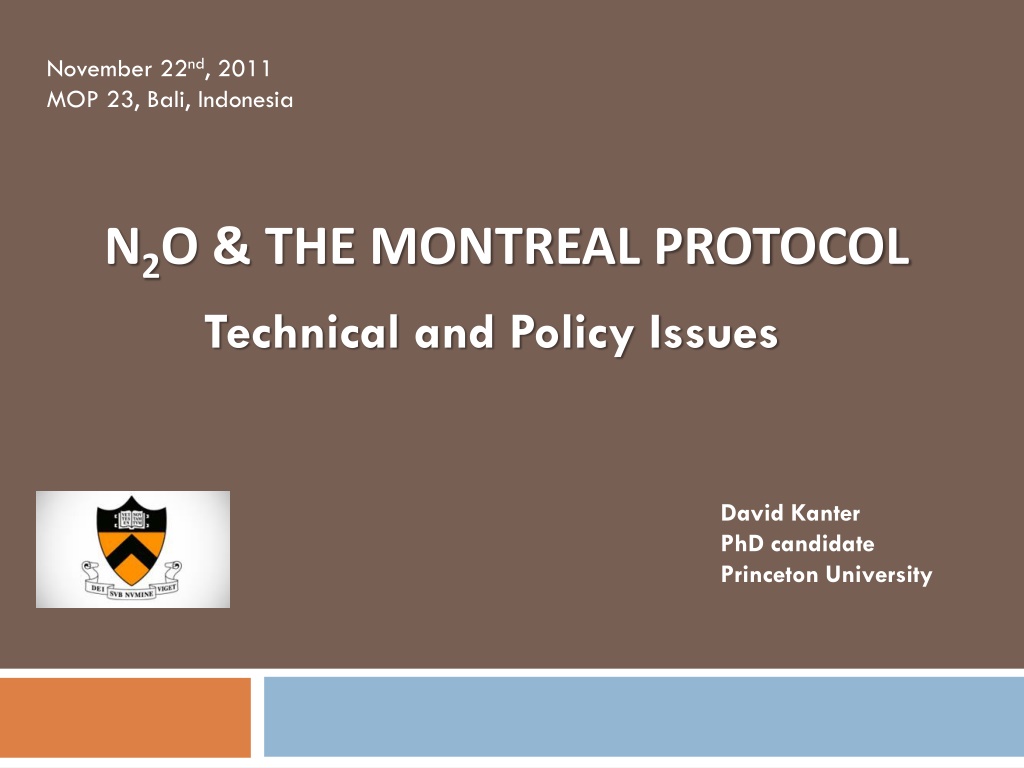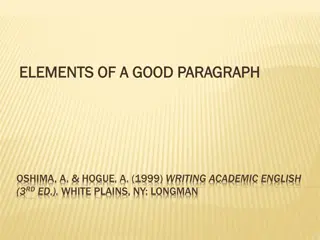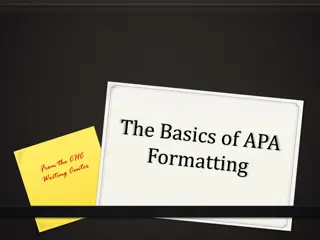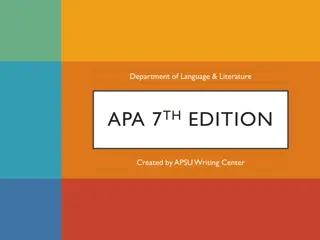Proper Paragraph Formatting Guidelines
Learn the correct format for writing paragraphs by following detailed instructions for handwritten and computer-written work. Understand the structure of a paragraph and how to present your ideas effectively.
Download Presentation

Please find below an Image/Link to download the presentation.
The content on the website is provided AS IS for your information and personal use only. It may not be sold, licensed, or shared on other websites without obtaining consent from the author.If you encounter any issues during the download, it is possible that the publisher has removed the file from their server.
You are allowed to download the files provided on this website for personal or commercial use, subject to the condition that they are used lawfully. All files are the property of their respective owners.
The content on the website is provided AS IS for your information and personal use only. It may not be sold, licensed, or shared on other websites without obtaining consent from the author.
E N D
Presentation Transcript
November 22nd, 2011 MOP 23, Bali, Indonesia N2O & THE MONTREAL PROTOCOL Technical and Policy Issues David Kanter PhD candidate Princeton University
Outline Breakdown of N2O emissions sources Point vs. non-point sources Global N2O emission trends Why should Montreal Protocol (MP) take on N2O? How can emissions be reduced? Industry & stationary/mobile combustion Agriculture Behavioral changes Technological opportunities How can targets be developed and implemented? Existing policies Assessment Panels and the Multilateral Fund (MLF) Conclusions & Next Steps
N2O emissions breakdown Point sources: Industry (from nitric acid and adipic acid production) Stationary combustion (e.g. coal power plants) Wastewater treatment facilities Non-point sources: Agriculture (synthetic fertilizer, manure, legumes ) Mobile combustion (transport) Biomass burning Princeton University (2011) Complements to Carbon
Global N2O Emission Trends (USEPA, 2011)
Why should MP take on N2O? N2O now most abundant ODS in atmosphere, with emissions projected to increase (Ravishankara et al. 2009) Current international tools for controlling N2O are weak Little attention to N2O within Kyoto Protocol CDM has focused solely on industrial N2O emissions Increasing calls to regulate non-CO2 climate forcers in non-UNFCCC forums (Molina et al. 2009; HFC Amendments 2009-2011) MP well-suited for N2O Rising N2O emissions threaten MP s continued success Effective, well-respected assessment panels Successful financial mechanism (MLF) Binding (common and differentiated) commitments of all Parties
Why are N2O reduction opportunities different? Much more publicly available information on N2O reduction strategies Industry associations acknowledge both environmental impacts of N2O and effectiveness of reduction strategies (e.g. International Fertilizer Industry Association (IFA) says N2O emissions can be reduced by 25% using existing practices and technologies IFA, 2009) Leading companies already developing and marketing abatement technologies (e.g. Yara International), in addition to publicizing best practices. N2O reductions have more environmental co-benefits (ozone, climate, air, water)
How emissions can be reduced: Industry et al. Nitric and adipic acid manufacturing Nitric acid: Catalytic reduction techniques, which reduce both N2O and NOx emissions by over 90% (SEI 2010). 20% of US plants have N2O abatement technology installed (USEPA, 2006) Adipic acid: Catalytic decomposition and thermal destruction techniques, which reduce N2O emissions by approx. 95% (USEPA 2011). 90% of US plants have N2O abatement technology installed (USEPA, 2006) Transport Next generation catalytic converters reduce N2O and NOx emissions (EPA/DoT regulations) Stationary combustion Improved combustion technologies (e.g. pressurized fluidized bed combustion) and catalytic reduction techniques (CARB)
How emissions can be reduced: Agriculture Behavioral practices Fertilizer best management practices (Robertson & Vitousek 2009): Watershed management Crop residue recycling Precision & split fertilizer application Legume cultivation/cover crop Manure management 4Rs: Right product, right rate, right time, right place (IFA)
How emissions can be reduced: Agriculture (Cont.) Technological solutions: Nitrification inhibitors Additives to traditional fertilizers that delay production of nitrate (NO3) Reduce N2O emissions by approx. 40% (Akiyama et al. 2009). Used on 10% of US maize cropland (Mosier et al., 2004) Controlled-release fertilizers Coating or chemical modification of fertilizer, which slows the rate of nutrient release. Reduce N2O emissions by approx. 35% (Akiyama et al., 2009) Used on <1% of US cropland due to cost (Mosier et al. 2004) Other Breeding and genetic engineering of crops to increase N use efficiency
How can reductions be implemented? Industrial emission reductions: Easiest to implement and could be addressed before agriculture. Technological solutions available for all facilities (of which there are a limited number). Agricultural N2O emissions: Begin with most cost effective reductions. N fertilizer is essential to crop production, but ~50% lost to the environment. Improvements would reduce costs and N pollution. Goal is to use existing N fertilizers more efficiently, as well as encourage adoption of new fertilizer technologies. Due to tight coupling of N cycle, care should be taken not to exacerbate other forms of N pollution while reducing N2O (Galloway et al., 2003).
Existing N Policies N2O: EU Emissions Trading Scheme (ETS) Credit for N2O emissions reductions from nitric acid plants will be issued starting in 2013. Alberta (Canada) Quantification Protocol for Agricultural N2O Emissions Reductions Issues credits for on-farm reductions of N2O emissions and fuel use associated with management of fertilizer, manure and crop residues. Kyoto Protocol - Handful of CDM projects to reduce industrial N2O emissions. US EPA/Dept. of Transportation Cap on tailpipe N2O emissions of 0.010g per mile. UK Climate Change Act N2O covered under a general GHG reduction target Australia Carbon Tax N2O to be covered Reactive N (indirect impact on N2O): EU -Nitrates Directive USA - Safe Drinking Water Act, Clean Water Act, Clean Air Act International - Convention on Long Range Transport of Air Pollution
Assessment Panels and MLF Assessment panels: Logical next step given N2O s threat to ozone layer would be to create new sub-panel within Technology and Economics Assessment Panel(Environmental Effects Panel & Scientific Assessment Panel already cover N2O see SAP, 2010). Experts exist on both environmental impacts of N2O and technical solutions across the globe in both the public and private sector. Multilateral Fund (MLF): Clear incremental costs and available technologies for industrial emissions abatement Similar strategy to methyl bromide for agricultural N2O emissions would be suitable - a mix of technology transfer and training, technical assistance and information dissemination projects.
Conclusions and next steps Conclusions: N2O s ozone depleting properties, weak international controls, as well as MP s institutional structure all favor inclusion of N2O in the MP. Significant N2O emission reductions are possible across most sectors Emissions reductions are already being implemented by a suite of policies, which should be harnessed by MP, but global controls necessary Next steps: TEAP (or TEAP-like) report (and/or a Special Report in conjunction with the IPCC) on N2O reduction opportunities. Industry workshop (under TEAP auspices) on N2O reduction opportunities.
References Akiyama et al. (2010) Evaluation of effectiveness of enhanced-efficiency fertilizers as mitigation options for N2O and NO emissions from agricultural soils: meta-analysis , Global Change Biology, 16:1837-1846 California Air Resources Board Options for N2O emission reductions related to stationary combustion (B.2.2) Galloway et al. (2003) The nitrogen cascade , Bioscience, 53, 341-356 IFA (2009) Fertilizers, climate change, and enhanced agricultural productivity sustainably Molina et al. (2009) Reducing abrupt climate change risk using the Montreal Protocol and other regulatory actions to complement cuts in CO2 emissions , PNAS Mosier et al. (2004) Agriculture and the Nitrogen Cycle (SCOPE) SEI (2010) Industrial N2O projects under the CDM: The case of nitric acid production , SEI Working Paper WP-US-1007 Robertson G.P., Vitousek P. (2009) Nitrogen in Agriculture: Balancing the Cost of an Essential Resource , Annu. Rev. Environ. Resour., 34:97-125 USEPA (2006) Global mitigation of non-CO2 greenhouse gases USEPA (2011) DRAFT: Global Anthropogenic Non-CO2 Greenhouse Gas Emissions: 1990 2030
Acknowledgements & Questions Thanks to Ravishankara and Pete Grabiel for their support and participation. Thanks to Professors Denise Mauzerall, Bill Moomaw (Tufts), Bob Keohane & Michael Oppenheimer for their on-going intellectual support. Thanks to Siebel Energy Challenge, Princeton Institute for International & Regional Studies (PIIRS), and Princeton Science Technology, and Environmental Policy (STEP) program for funding this trip. Questions?

 undefined
undefined

























